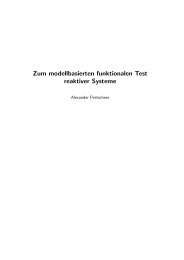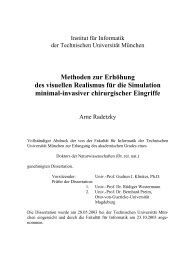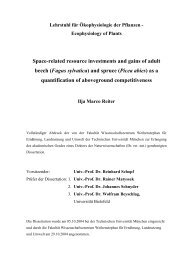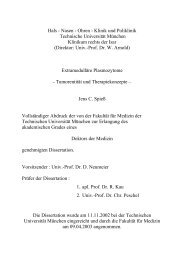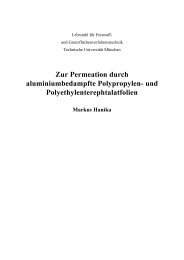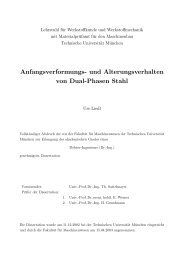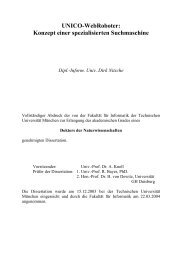Topologically Defined Neuronal Networks Controlled by Silicon Chips
Topologically Defined Neuronal Networks Controlled by Silicon Chips
Topologically Defined Neuronal Networks Controlled by Silicon Chips
Create successful ePaper yourself
Turn your PDF publications into a flip-book with our unique Google optimized e-Paper software.
CHAPTER 2. NETWORKS OF DEFINED TOPOGRAPHY<br />
with this technique, ranging from the denaturation of laminin [42], growth factors [81], ECM [35] and<br />
ablation of poly-L-lysine [15, 87] to the photocleavage of covalently bound organosilane monolayers<br />
[24].<br />
Conversely, UV light can also be used to selectively bind molecules in exposed areas to the substrate<br />
<strong>by</strong> special photoreactive cross-linkers [5].<br />
Softlithography is the general term for a number of methods that use soft devices (usually consisting<br />
of PDMS, polydimethylsiloxane, Sylgard 184, Dow-Corning) to stamp or generate chemical tracks <strong>by</strong><br />
capillary flow. They are made <strong>by</strong> curing a prepolymer on a photoresist master or structures etched into<br />
a Si-wafer.<br />
Stamps wetted with ‘ink’ (guidance molecules) are gently pressed onto the substrate. Molecules attach<br />
to the surface and reproduce the raised areas of the stamp. G.M. Whitesides was the first to use microcontact<br />
printing for covalently linking thiol patterns to gold surfaces [97].<br />
Microfluidic networks consist of PDMS membranes with relief structures that seal tightly against planar<br />
surfaces, forming micro-conduits [21]. Solutions are driven into the network of channels <strong>by</strong> capillary<br />
forces or application of pressure. Molecules adhere to the channel walls, one of which being<br />
the substrate. Removing the PDMS device leaves a pattern identical to the conduits on the surface,<br />
see Fig.2.2E. Complex structures with lanes of different molecules can be produced in a single step <strong>by</strong><br />
multiple laminar fluid flow in capillary networks [11, 109].<br />
Softlithography is an easy to use, inexpensive technique for producing complex patterns of surfacebound<br />
molecules. Except for master fabrication, no cleanroom equipment is required. Resolution is<br />
slightly reduced as compared to photolithography, but feature sizes down to 2µm are more than sufficient<br />
for most biological applications. For more information refer to the comprehensive reviews <strong>by</strong><br />
G.M. Whitesides et al. [54, 127]<br />
So far, all protocols resulted in chemical patterns surrounded <strong>by</strong> blank substrate. To increase directional<br />
information these areas are often coated with molecules bearing the complementary signal [56],<br />
e.g growth-promoting tracks surrounded <strong>by</strong> inhibitory regions. This is simply done <strong>by</strong> incubating the<br />
respective molecules on the prepatterned substrates as they only bind to the blank but not to the functionalized<br />
areas. The synergistic action of both cues increases directional information on growth-cones.<br />
This is especially important to prevent non-specific binding of serum (sometimes used with the culture<br />
medium) or proteins released <strong>by</strong> cells to the surface, which otherwise reduce the potency of the initial<br />
cues.<br />
2.1.3 Substrate topography<br />
In vivo, topographic features of the surrounding tissue provide morphogenetic guidance cues to growthcones.<br />
For example, growing axons fasciculate with pioneer axons, follow them for a certain distance,<br />
and defasciculate again. During fasciculated outgrowth, the growth-cone of the elongating axon is in<br />
physical contact with the pioneer axon and follows its topographic information.<br />
In vitro experiments are an elegant way to study the so far poorly understood signal transduction pathways<br />
involved in contact-mediated guidance and the role of the cytoskeleton [84]. Chemical cues<br />
abundant in in vivo systems can be completely excluded, leaving topographic structures as the only<br />
environmental information. A multitude of cells such as neurons, astroglial cells, MDCK, epithelial<br />
cells and many more were explanted onto glass, polymer and silicon substrates with rough surfaces or<br />
regular structures such as steps and grooves, with feature sizes ranging from nanometers to micrometers;<br />
see reviews <strong>by</strong> [4, 18, 19, 22, 29, 52].<br />
For example, astroglial cells preferentially grow on top of a regular array of columns with 0.5µm diameter<br />
etched into silicon, while avoiding irregular nanometer-sized surface roughness [17]. BHK cells and<br />
8


